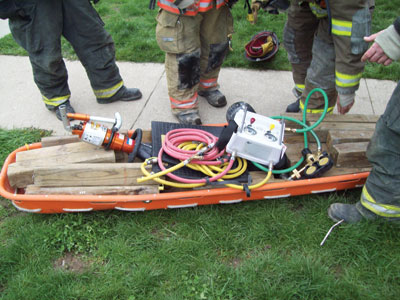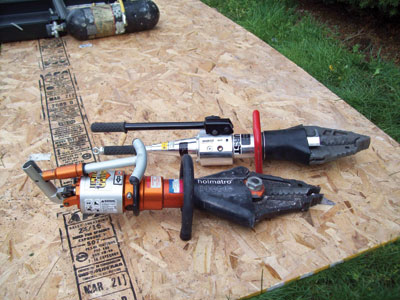
Back to Basics: April 2011
Mark Van
Features Fire Ground TrainingDuring rapid intervention team (RIT) operations, it’s important to consider ways to increase the mayday firefighter’s chances of survival.
During rapid intervention team (RIT) operations, it’s important to consider ways to increase the mayday firefighter’s chances of survival. This can be done by applying the AWARE acronym to every rescue of a mayday firefighter: Air, Water, A Radio and Extrication. This acronym helps the incident commander with the RIT operation and it will help RIT members remember what to address first, second, third and last with respect to the rescue. We have already looked at air, water and radio. Now we’ll look at extrication.
 |

|
| Photo 1. All the hydraulic lines are pre-connected prior to entering the structure. Photo by Mark van der Feyst |
Photo 2. Two styles of manual hydraulic spreaders that can be used for interior operations. Photo by Mark van der Feyst |
Hand and power tools are necessary to help rescuers with rapid intervention team operations. There are many options when considering which tools to use; all tools used for auto extrication and structural firefighting operations are at our disposal. In addition, specialized tools have been developed for the needs of RIT operations, such as the manual hydraulic spreader/cutter shown in photo 2.
It is important to use extreme caution when operating tools in a smoke-filled environment. Safety is the primary concern for all parties involved in a RIT operation. Because visibility can be reduced due to smoke, it is paramount to account for all team members and victims prior to lifting, cutting or swinging, as it is easy to injure another rescuer with a hand tool such as an axe or a maul. Using short, controlled swings is recommended when visibility is limited. To increase safety even further, it is wise to assign an operations officer to be on the inside to co-ordinate the operation while overseeing safety.
When a RIT member is cutting, it is vital to confirm what is being cut to make sure that further damage or injury does not occur. This is especially important when cutting wires or other entanglement hazards from the mayday firefighter. It is very easy to grab and cut a vital piece of SCBA equipment such as the regulator hose, thinking that it is an entanglement hazard. Grab the entanglement,verify what it is, then cut.
This advice can also be applied when using chainsaws or other devices. When making a large opening, the crew on the outside cannot see where anyone is on the inside. When the chainsaw is plunged through the wall, it can easily injure a rescuer or the mayday firefighter. A safety person is needed to oversee the cutting operation from the inside to keep the area clear of all personnel and to direct the cutting operation. Communication between the interior safety person and the outside cutting crew is essential.
In addition, it is a good idea to bring portable electric lights into the operation area. If this is not possible, setting up portable lights outside the structure at the window will work. The use of aerial devices is another option when RIT operations are on an upper floor – use the spotlights on the ladder tip. Another way to increase visibility is to ventilate the structure. Calling for tactical ventilation by means of positive pressure fans, hydraulic expulsion, enlarged openings or vertical vent holes will remove the smoke and heat.
Another safety concern during RIT operations is the shifting of heaving loads, especially when using lifting devices to raise heavy objects. Stability of the load is paramount to prevent secondary collapse. Using cribbing to stabilize the load as the lift is underway prevents the load from shifting or collapsing. Shifting of the load can be caused by other team members bumping into or leaning on the load, or by the activities of the other operating crews. The interior safety, or operations, officer needs to ensure that all personnel are kept well clear of the load and that the lifting operation is going smoothly. Periodically checking the cribbing will help.
Another important consideration during RIT operations is the use of gasoline-powered tools. These tools work best in a clean-air environment. Chainsaws and hydraulic tool power units run on gasoline and need to have a proper fuel/air mixture to operate optimally. Power tools do not work well when used in or around a smoke-filled environment. It is best to set the hydraulic generator unit outside the structure and run the hydraulic lines inside the structure using extension lines. Using electrically powered cutting tools such as a reciprocating saw alleviates this problem. These types of tools can be powered by batteries for cordless operation or by running an electrical line into the structure. If using cordless tools, the battery life will be the weak link in the operation. Ensuring that the batteries are fully charged, and having a spare set of batteries, is essential. Cordless tools are great for starting the operation until hard-wired electrical tools arrive.
When using hydraulic rescue tools, it is important to connect the lines before entering the structure (see photo 1 on page 22). If the lines are not connected, it will be difficult to connect them inside in poor visibility and this will add to the length of the response. If the lines are too short or will not work properly, use a manual pump hydraulic spreader/cutter such as that in photo 2 on page 22.
This concludes our look at tactical considerations for a RIT operation. In the July issue, we will start to explore some of the practical drills that can be implemented to increase rescue efforts for a mayday firefighter.
Mark van der Feyst is an 11-year veteran of the fire service. He currently works for the City of Woodstock Fire Department in Ontario. Mark is an international instructor teaching in Canada, the United States and India. He is a Local Level Suppression Instructor for the Pennsylvania State Fire Academy, an Instructor for the Justice Institute of British Columbia and a professor of fire science at Lambton College. E-mail him at Mark@FireStarTraining.com.
Print this page